A Study on Employee Motivation and Performance at Diacom
VerifiedAdded on 2020/06/04
|31
|3835
|132
Report
AI Summary
This report examines employee work motivation and its effects on performance and business productivity at Diacom Telephony. The study explores the relationship between employee motivation and various factors, including financial rewards, job security, and decision-making involvement. Through thematic analysis of survey data, the research identifies key motivators such as salary increments and the impact of motivation on business productivity. The findings highlight the importance of job security, workplace flexibility, and employee involvement in decision-making. The report concludes with recommendations to enhance employee performance and overall business outcomes, emphasizing the need for financial incentives, recognition, and a positive work environment. The report provides a detailed analysis of the current state of employee motivation and its impact on the success of Diacom Telephony.
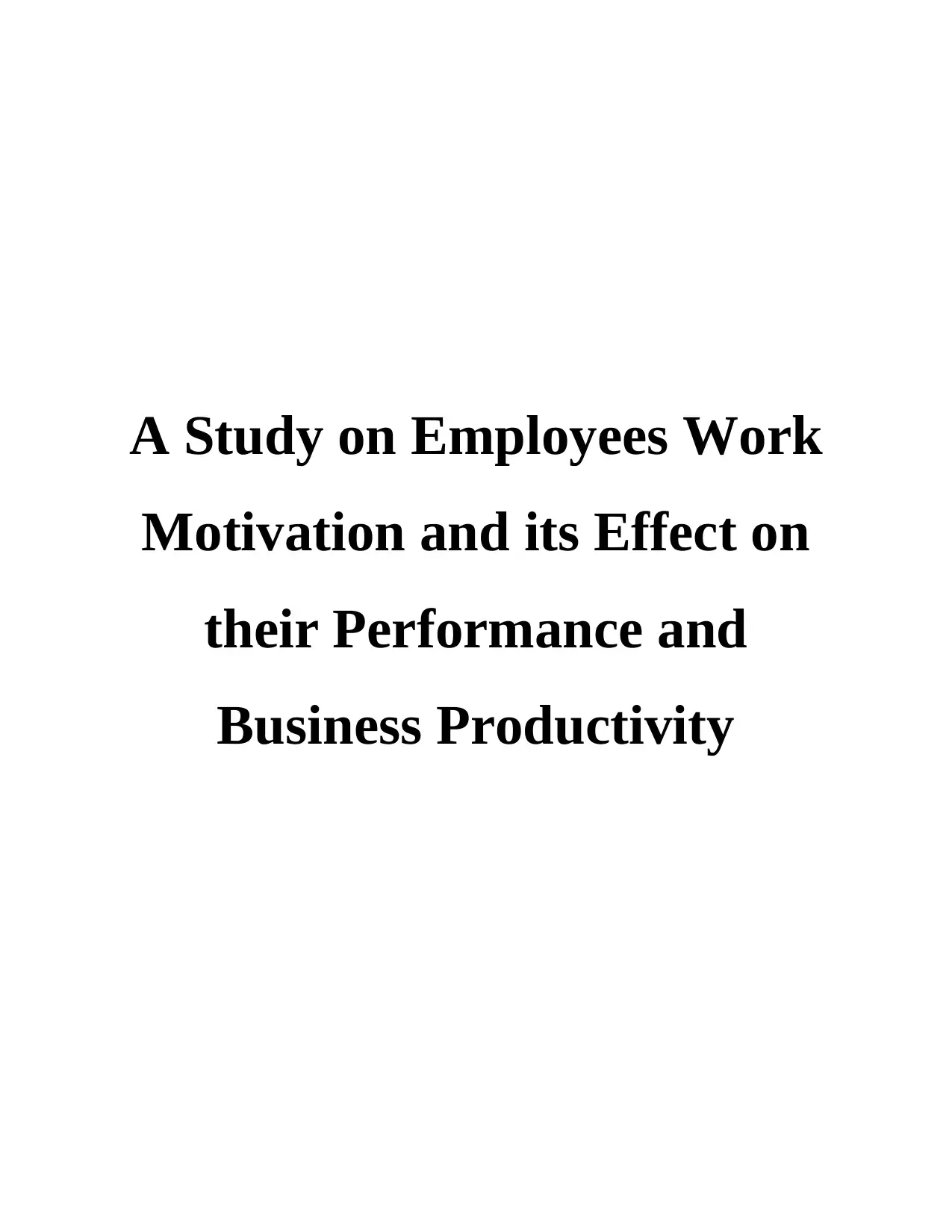
A Study on Employees Work
Motivation and its Effect on
their Performance and
Business Productivity
Motivation and its Effect on
their Performance and
Business Productivity
Paraphrase This Document
Need a fresh take? Get an instant paraphrase of this document with our AI Paraphraser
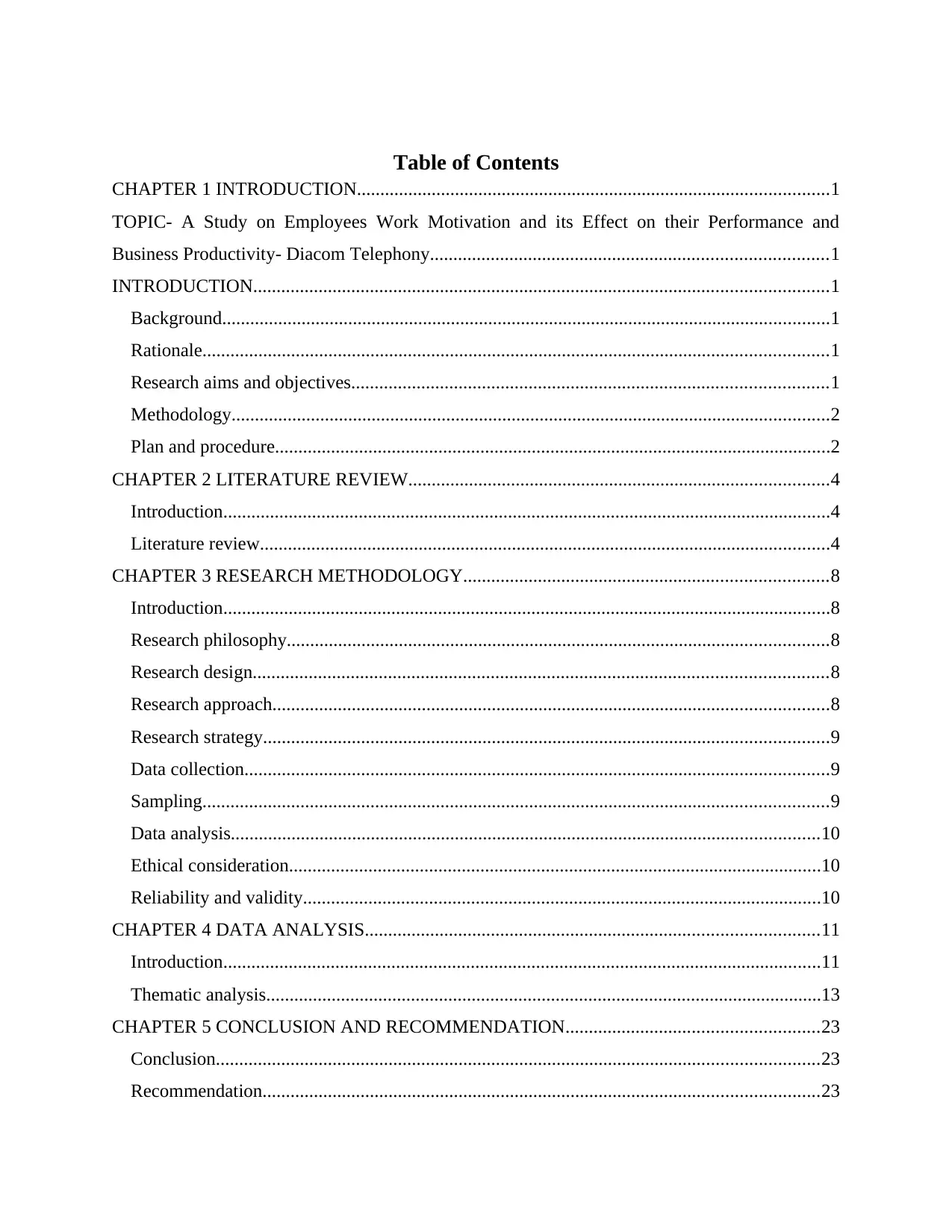
Table of Contents
CHAPTER 1 INTRODUCTION.....................................................................................................1
TOPIC- A Study on Employees Work Motivation and its Effect on their Performance and
Business Productivity- Diacom Telephony.....................................................................................1
INTRODUCTION...........................................................................................................................1
Background..................................................................................................................................1
Rationale......................................................................................................................................1
Research aims and objectives......................................................................................................1
Methodology................................................................................................................................2
Plan and procedure.......................................................................................................................2
CHAPTER 2 LITERATURE REVIEW..........................................................................................4
Introduction..................................................................................................................................4
Literature review..........................................................................................................................4
CHAPTER 3 RESEARCH METHODOLOGY..............................................................................8
Introduction..................................................................................................................................8
Research philosophy....................................................................................................................8
Research design...........................................................................................................................8
Research approach.......................................................................................................................8
Research strategy.........................................................................................................................9
Data collection.............................................................................................................................9
Sampling......................................................................................................................................9
Data analysis..............................................................................................................................10
Ethical consideration..................................................................................................................10
Reliability and validity...............................................................................................................10
CHAPTER 4 DATA ANALYSIS.................................................................................................11
Introduction................................................................................................................................11
Thematic analysis.......................................................................................................................13
CHAPTER 5 CONCLUSION AND RECOMMENDATION......................................................23
Conclusion.................................................................................................................................23
Recommendation.......................................................................................................................23
CHAPTER 1 INTRODUCTION.....................................................................................................1
TOPIC- A Study on Employees Work Motivation and its Effect on their Performance and
Business Productivity- Diacom Telephony.....................................................................................1
INTRODUCTION...........................................................................................................................1
Background..................................................................................................................................1
Rationale......................................................................................................................................1
Research aims and objectives......................................................................................................1
Methodology................................................................................................................................2
Plan and procedure.......................................................................................................................2
CHAPTER 2 LITERATURE REVIEW..........................................................................................4
Introduction..................................................................................................................................4
Literature review..........................................................................................................................4
CHAPTER 3 RESEARCH METHODOLOGY..............................................................................8
Introduction..................................................................................................................................8
Research philosophy....................................................................................................................8
Research design...........................................................................................................................8
Research approach.......................................................................................................................8
Research strategy.........................................................................................................................9
Data collection.............................................................................................................................9
Sampling......................................................................................................................................9
Data analysis..............................................................................................................................10
Ethical consideration..................................................................................................................10
Reliability and validity...............................................................................................................10
CHAPTER 4 DATA ANALYSIS.................................................................................................11
Introduction................................................................................................................................11
Thematic analysis.......................................................................................................................13
CHAPTER 5 CONCLUSION AND RECOMMENDATION......................................................23
Conclusion.................................................................................................................................23
Recommendation.......................................................................................................................23

REFERENCES................................................................................................................................1
⊘ This is a preview!⊘
Do you want full access?
Subscribe today to unlock all pages.

Trusted by 1+ million students worldwide
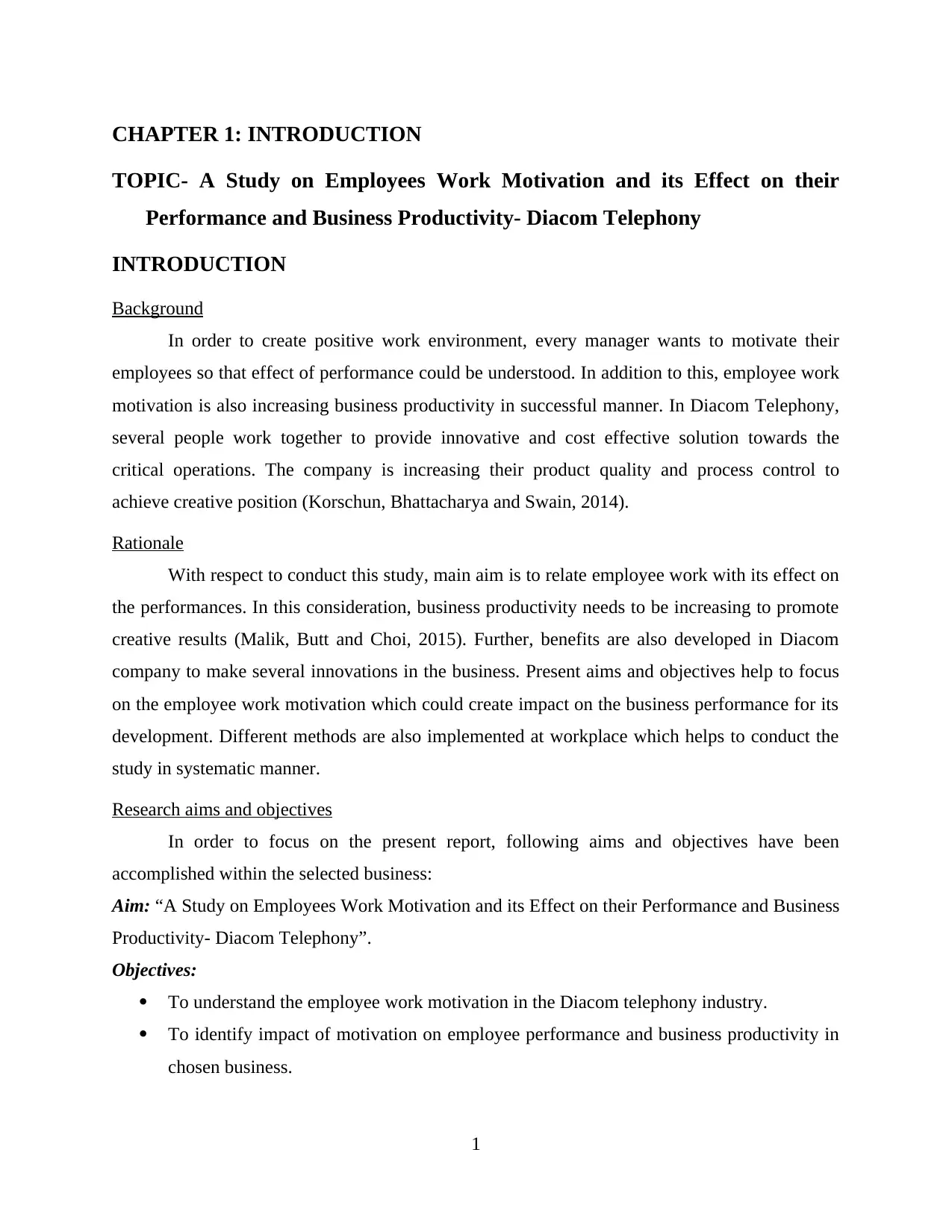
CHAPTER 1: INTRODUCTION
TOPIC- A Study on Employees Work Motivation and its Effect on their
Performance and Business Productivity- Diacom Telephony
INTRODUCTION
Background
In order to create positive work environment, every manager wants to motivate their
employees so that effect of performance could be understood. In addition to this, employee work
motivation is also increasing business productivity in successful manner. In Diacom Telephony,
several people work together to provide innovative and cost effective solution towards the
critical operations. The company is increasing their product quality and process control to
achieve creative position (Korschun, Bhattacharya and Swain, 2014).
Rationale
With respect to conduct this study, main aim is to relate employee work with its effect on
the performances. In this consideration, business productivity needs to be increasing to promote
creative results (Malik, Butt and Choi, 2015). Further, benefits are also developed in Diacom
company to make several innovations in the business. Present aims and objectives help to focus
on the employee work motivation which could create impact on the business performance for its
development. Different methods are also implemented at workplace which helps to conduct the
study in systematic manner.
Research aims and objectives
In order to focus on the present report, following aims and objectives have been
accomplished within the selected business:
Aim: “A Study on Employees Work Motivation and its Effect on their Performance and Business
Productivity- Diacom Telephony”.
Objectives:
To understand the employee work motivation in the Diacom telephony industry.
To identify impact of motivation on employee performance and business productivity in
chosen business.
1
TOPIC- A Study on Employees Work Motivation and its Effect on their
Performance and Business Productivity- Diacom Telephony
INTRODUCTION
Background
In order to create positive work environment, every manager wants to motivate their
employees so that effect of performance could be understood. In addition to this, employee work
motivation is also increasing business productivity in successful manner. In Diacom Telephony,
several people work together to provide innovative and cost effective solution towards the
critical operations. The company is increasing their product quality and process control to
achieve creative position (Korschun, Bhattacharya and Swain, 2014).
Rationale
With respect to conduct this study, main aim is to relate employee work with its effect on
the performances. In this consideration, business productivity needs to be increasing to promote
creative results (Malik, Butt and Choi, 2015). Further, benefits are also developed in Diacom
company to make several innovations in the business. Present aims and objectives help to focus
on the employee work motivation which could create impact on the business performance for its
development. Different methods are also implemented at workplace which helps to conduct the
study in systematic manner.
Research aims and objectives
In order to focus on the present report, following aims and objectives have been
accomplished within the selected business:
Aim: “A Study on Employees Work Motivation and its Effect on their Performance and Business
Productivity- Diacom Telephony”.
Objectives:
To understand the employee work motivation in the Diacom telephony industry.
To identify impact of motivation on employee performance and business productivity in
chosen business.
1
Paraphrase This Document
Need a fresh take? Get an instant paraphrase of this document with our AI Paraphraser
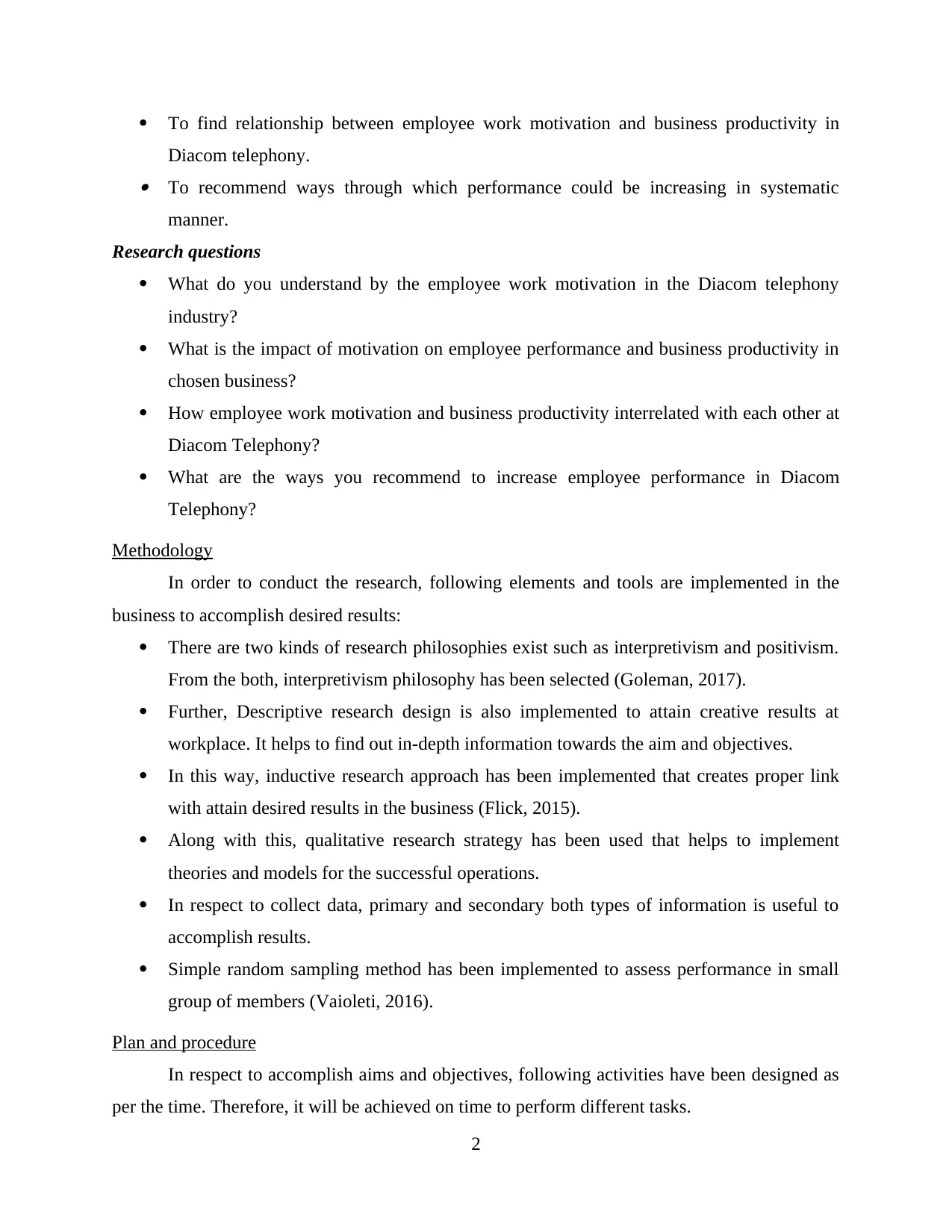
To find relationship between employee work motivation and business productivity in
Diacom telephony. To recommend ways through which performance could be increasing in systematic
manner.
Research questions
What do you understand by the employee work motivation in the Diacom telephony
industry?
What is the impact of motivation on employee performance and business productivity in
chosen business?
How employee work motivation and business productivity interrelated with each other at
Diacom Telephony?
What are the ways you recommend to increase employee performance in Diacom
Telephony?
Methodology
In order to conduct the research, following elements and tools are implemented in the
business to accomplish desired results:
There are two kinds of research philosophies exist such as interpretivism and positivism.
From the both, interpretivism philosophy has been selected (Goleman, 2017).
Further, Descriptive research design is also implemented to attain creative results at
workplace. It helps to find out in-depth information towards the aim and objectives.
In this way, inductive research approach has been implemented that creates proper link
with attain desired results in the business (Flick, 2015).
Along with this, qualitative research strategy has been used that helps to implement
theories and models for the successful operations.
In respect to collect data, primary and secondary both types of information is useful to
accomplish results.
Simple random sampling method has been implemented to assess performance in small
group of members (Vaioleti, 2016).
Plan and procedure
In respect to accomplish aims and objectives, following activities have been designed as
per the time. Therefore, it will be achieved on time to perform different tasks.
2
Diacom telephony. To recommend ways through which performance could be increasing in systematic
manner.
Research questions
What do you understand by the employee work motivation in the Diacom telephony
industry?
What is the impact of motivation on employee performance and business productivity in
chosen business?
How employee work motivation and business productivity interrelated with each other at
Diacom Telephony?
What are the ways you recommend to increase employee performance in Diacom
Telephony?
Methodology
In order to conduct the research, following elements and tools are implemented in the
business to accomplish desired results:
There are two kinds of research philosophies exist such as interpretivism and positivism.
From the both, interpretivism philosophy has been selected (Goleman, 2017).
Further, Descriptive research design is also implemented to attain creative results at
workplace. It helps to find out in-depth information towards the aim and objectives.
In this way, inductive research approach has been implemented that creates proper link
with attain desired results in the business (Flick, 2015).
Along with this, qualitative research strategy has been used that helps to implement
theories and models for the successful operations.
In respect to collect data, primary and secondary both types of information is useful to
accomplish results.
Simple random sampling method has been implemented to assess performance in small
group of members (Vaioleti, 2016).
Plan and procedure
In respect to accomplish aims and objectives, following activities have been designed as
per the time. Therefore, it will be achieved on time to perform different tasks.
2
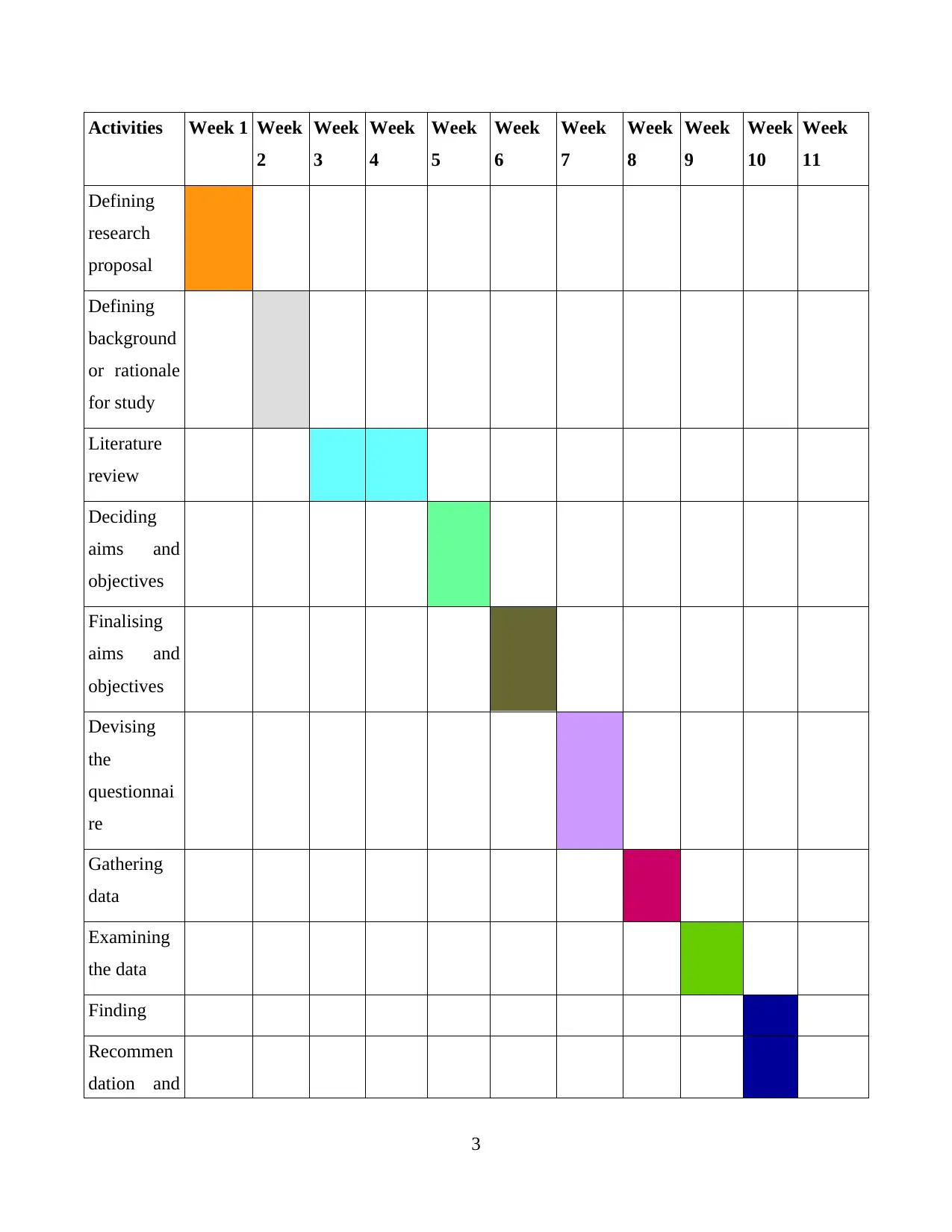
Activities Week 1 Week
2
Week
3
Week
4
Week
5
Week
6
Week
7
Week
8
Week
9
Week
10
Week
11
Defining
research
proposal
Defining
background
or rationale
for study
Literature
review
Deciding
aims and
objectives
Finalising
aims and
objectives
Devising
the
questionnai
re
Gathering
data
Examining
the data
Finding
Recommen
dation and
3
2
Week
3
Week
4
Week
5
Week
6
Week
7
Week
8
Week
9
Week
10
Week
11
Defining
research
proposal
Defining
background
or rationale
for study
Literature
review
Deciding
aims and
objectives
Finalising
aims and
objectives
Devising
the
questionnai
re
Gathering
data
Examining
the data
Finding
Recommen
dation and
3
⊘ This is a preview!⊘
Do you want full access?
Subscribe today to unlock all pages.

Trusted by 1+ million students worldwide
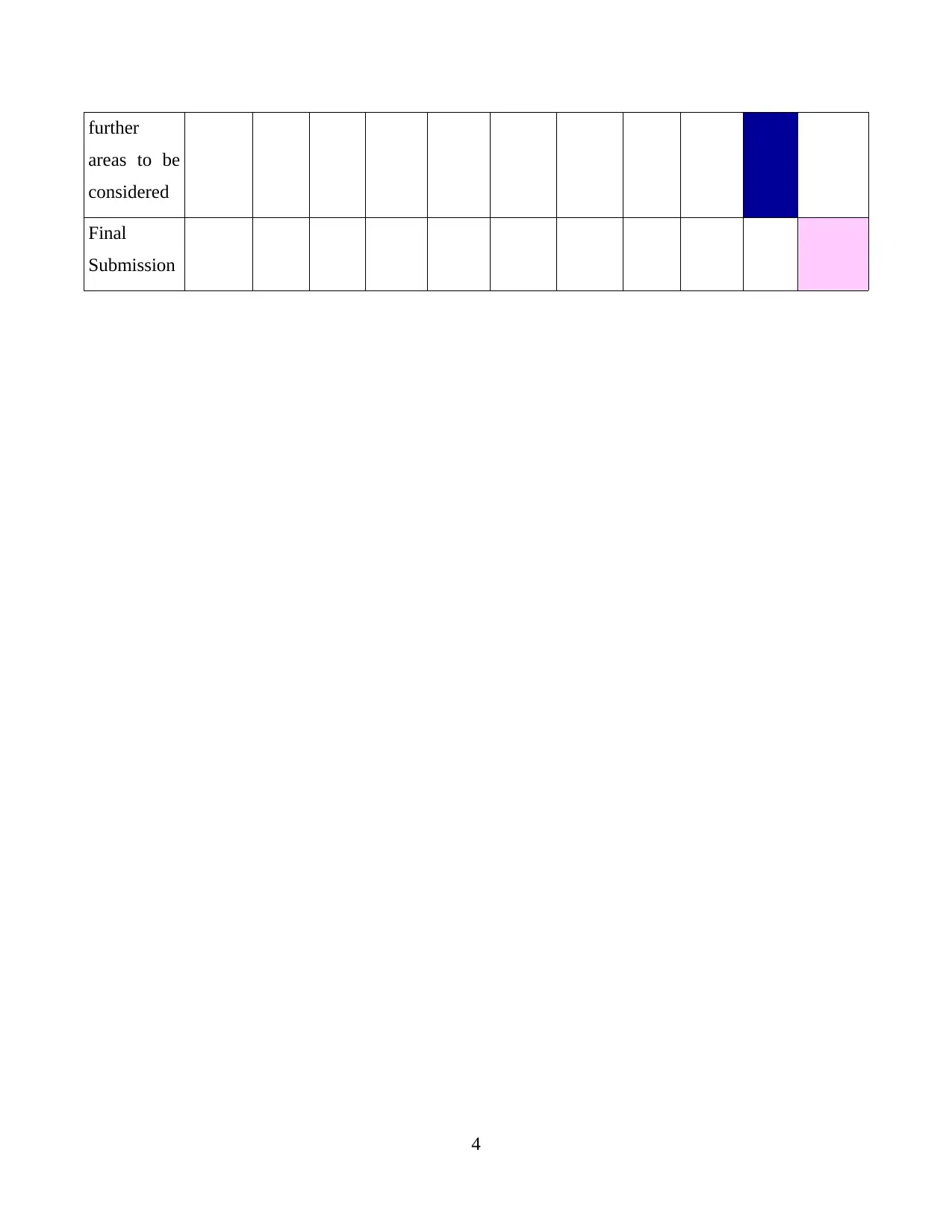
further
areas to be
considered
Final
Submission
4
areas to be
considered
Final
Submission
4
Paraphrase This Document
Need a fresh take? Get an instant paraphrase of this document with our AI Paraphraser
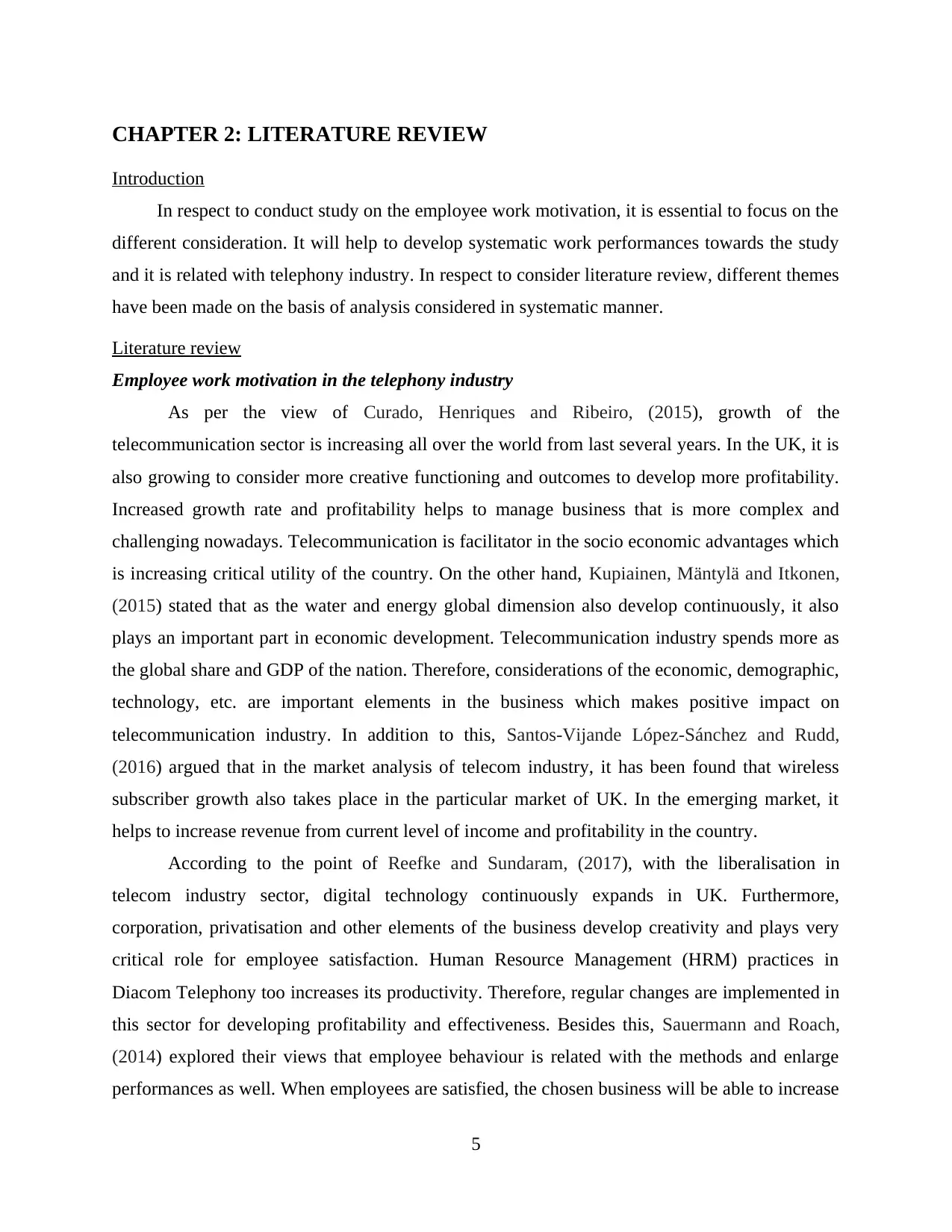
CHAPTER 2: LITERATURE REVIEW
Introduction
In respect to conduct study on the employee work motivation, it is essential to focus on the
different consideration. It will help to develop systematic work performances towards the study
and it is related with telephony industry. In respect to consider literature review, different themes
have been made on the basis of analysis considered in systematic manner.
Literature review
Employee work motivation in the telephony industry
As per the view of Curado, Henriques and Ribeiro, (2015), growth of the
telecommunication sector is increasing all over the world from last several years. In the UK, it is
also growing to consider more creative functioning and outcomes to develop more profitability.
Increased growth rate and profitability helps to manage business that is more complex and
challenging nowadays. Telecommunication is facilitator in the socio economic advantages which
is increasing critical utility of the country. On the other hand, Kupiainen, Mäntylä and Itkonen,
(2015) stated that as the water and energy global dimension also develop continuously, it also
plays an important part in economic development. Telecommunication industry spends more as
the global share and GDP of the nation. Therefore, considerations of the economic, demographic,
technology, etc. are important elements in the business which makes positive impact on
telecommunication industry. In addition to this, Santos-Vijande López-Sánchez and Rudd,
(2016) argued that in the market analysis of telecom industry, it has been found that wireless
subscriber growth also takes place in the particular market of UK. In the emerging market, it
helps to increase revenue from current level of income and profitability in the country.
According to the point of Reefke and Sundaram, (2017), with the liberalisation in
telecom industry sector, digital technology continuously expands in UK. Furthermore,
corporation, privatisation and other elements of the business develop creativity and plays very
critical role for employee satisfaction. Human Resource Management (HRM) practices in
Diacom Telephony too increases its productivity. Therefore, regular changes are implemented in
this sector for developing profitability and effectiveness. Besides this, Sauermann and Roach,
(2014) explored their views that employee behaviour is related with the methods and enlarge
performances as well. When employees are satisfied, the chosen business will be able to increase
5
Introduction
In respect to conduct study on the employee work motivation, it is essential to focus on the
different consideration. It will help to develop systematic work performances towards the study
and it is related with telephony industry. In respect to consider literature review, different themes
have been made on the basis of analysis considered in systematic manner.
Literature review
Employee work motivation in the telephony industry
As per the view of Curado, Henriques and Ribeiro, (2015), growth of the
telecommunication sector is increasing all over the world from last several years. In the UK, it is
also growing to consider more creative functioning and outcomes to develop more profitability.
Increased growth rate and profitability helps to manage business that is more complex and
challenging nowadays. Telecommunication is facilitator in the socio economic advantages which
is increasing critical utility of the country. On the other hand, Kupiainen, Mäntylä and Itkonen,
(2015) stated that as the water and energy global dimension also develop continuously, it also
plays an important part in economic development. Telecommunication industry spends more as
the global share and GDP of the nation. Therefore, considerations of the economic, demographic,
technology, etc. are important elements in the business which makes positive impact on
telecommunication industry. In addition to this, Santos-Vijande López-Sánchez and Rudd,
(2016) argued that in the market analysis of telecom industry, it has been found that wireless
subscriber growth also takes place in the particular market of UK. In the emerging market, it
helps to increase revenue from current level of income and profitability in the country.
According to the point of Reefke and Sundaram, (2017), with the liberalisation in
telecom industry sector, digital technology continuously expands in UK. Furthermore,
corporation, privatisation and other elements of the business develop creativity and plays very
critical role for employee satisfaction. Human Resource Management (HRM) practices in
Diacom Telephony too increases its productivity. Therefore, regular changes are implemented in
this sector for developing profitability and effectiveness. Besides this, Sauermann and Roach,
(2014) explored their views that employee behaviour is related with the methods and enlarge
performances as well. When employees are satisfied, the chosen business will be able to increase
5
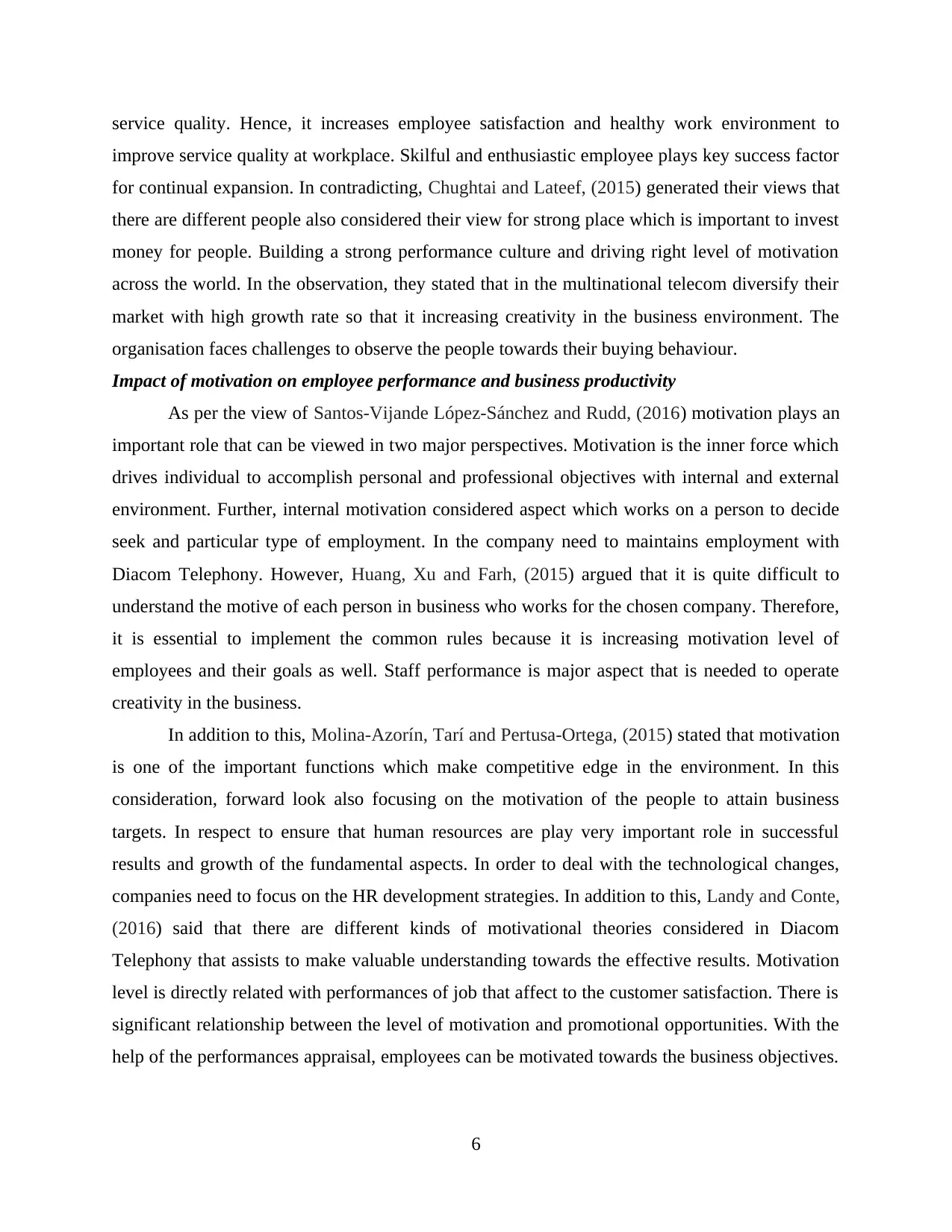
service quality. Hence, it increases employee satisfaction and healthy work environment to
improve service quality at workplace. Skilful and enthusiastic employee plays key success factor
for continual expansion. In contradicting, Chughtai and Lateef, (2015) generated their views that
there are different people also considered their view for strong place which is important to invest
money for people. Building a strong performance culture and driving right level of motivation
across the world. In the observation, they stated that in the multinational telecom diversify their
market with high growth rate so that it increasing creativity in the business environment. The
organisation faces challenges to observe the people towards their buying behaviour.
Impact of motivation on employee performance and business productivity
As per the view of Santos-Vijande López-Sánchez and Rudd, (2016) motivation plays an
important role that can be viewed in two major perspectives. Motivation is the inner force which
drives individual to accomplish personal and professional objectives with internal and external
environment. Further, internal motivation considered aspect which works on a person to decide
seek and particular type of employment. In the company need to maintains employment with
Diacom Telephony. However, Huang, Xu and Farh, (2015) argued that it is quite difficult to
understand the motive of each person in business who works for the chosen company. Therefore,
it is essential to implement the common rules because it is increasing motivation level of
employees and their goals as well. Staff performance is major aspect that is needed to operate
creativity in the business.
In addition to this, Molina-Azorín, Tarí and Pertusa-Ortega, (2015) stated that motivation
is one of the important functions which make competitive edge in the environment. In this
consideration, forward look also focusing on the motivation of the people to attain business
targets. In respect to ensure that human resources are play very important role in successful
results and growth of the fundamental aspects. In order to deal with the technological changes,
companies need to focus on the HR development strategies. In addition to this, Landy and Conte,
(2016) said that there are different kinds of motivational theories considered in Diacom
Telephony that assists to make valuable understanding towards the effective results. Motivation
level is directly related with performances of job that affect to the customer satisfaction. There is
significant relationship between the level of motivation and promotional opportunities. With the
help of the performances appraisal, employees can be motivated towards the business objectives.
6
improve service quality at workplace. Skilful and enthusiastic employee plays key success factor
for continual expansion. In contradicting, Chughtai and Lateef, (2015) generated their views that
there are different people also considered their view for strong place which is important to invest
money for people. Building a strong performance culture and driving right level of motivation
across the world. In the observation, they stated that in the multinational telecom diversify their
market with high growth rate so that it increasing creativity in the business environment. The
organisation faces challenges to observe the people towards their buying behaviour.
Impact of motivation on employee performance and business productivity
As per the view of Santos-Vijande López-Sánchez and Rudd, (2016) motivation plays an
important role that can be viewed in two major perspectives. Motivation is the inner force which
drives individual to accomplish personal and professional objectives with internal and external
environment. Further, internal motivation considered aspect which works on a person to decide
seek and particular type of employment. In the company need to maintains employment with
Diacom Telephony. However, Huang, Xu and Farh, (2015) argued that it is quite difficult to
understand the motive of each person in business who works for the chosen company. Therefore,
it is essential to implement the common rules because it is increasing motivation level of
employees and their goals as well. Staff performance is major aspect that is needed to operate
creativity in the business.
In addition to this, Molina-Azorín, Tarí and Pertusa-Ortega, (2015) stated that motivation
is one of the important functions which make competitive edge in the environment. In this
consideration, forward look also focusing on the motivation of the people to attain business
targets. In respect to ensure that human resources are play very important role in successful
results and growth of the fundamental aspects. In order to deal with the technological changes,
companies need to focus on the HR development strategies. In addition to this, Landy and Conte,
(2016) said that there are different kinds of motivational theories considered in Diacom
Telephony that assists to make valuable understanding towards the effective results. Motivation
level is directly related with performances of job that affect to the customer satisfaction. There is
significant relationship between the level of motivation and promotional opportunities. With the
help of the performances appraisal, employees can be motivated towards the business objectives.
6
⊘ This is a preview!⊘
Do you want full access?
Subscribe today to unlock all pages.

Trusted by 1+ million students worldwide
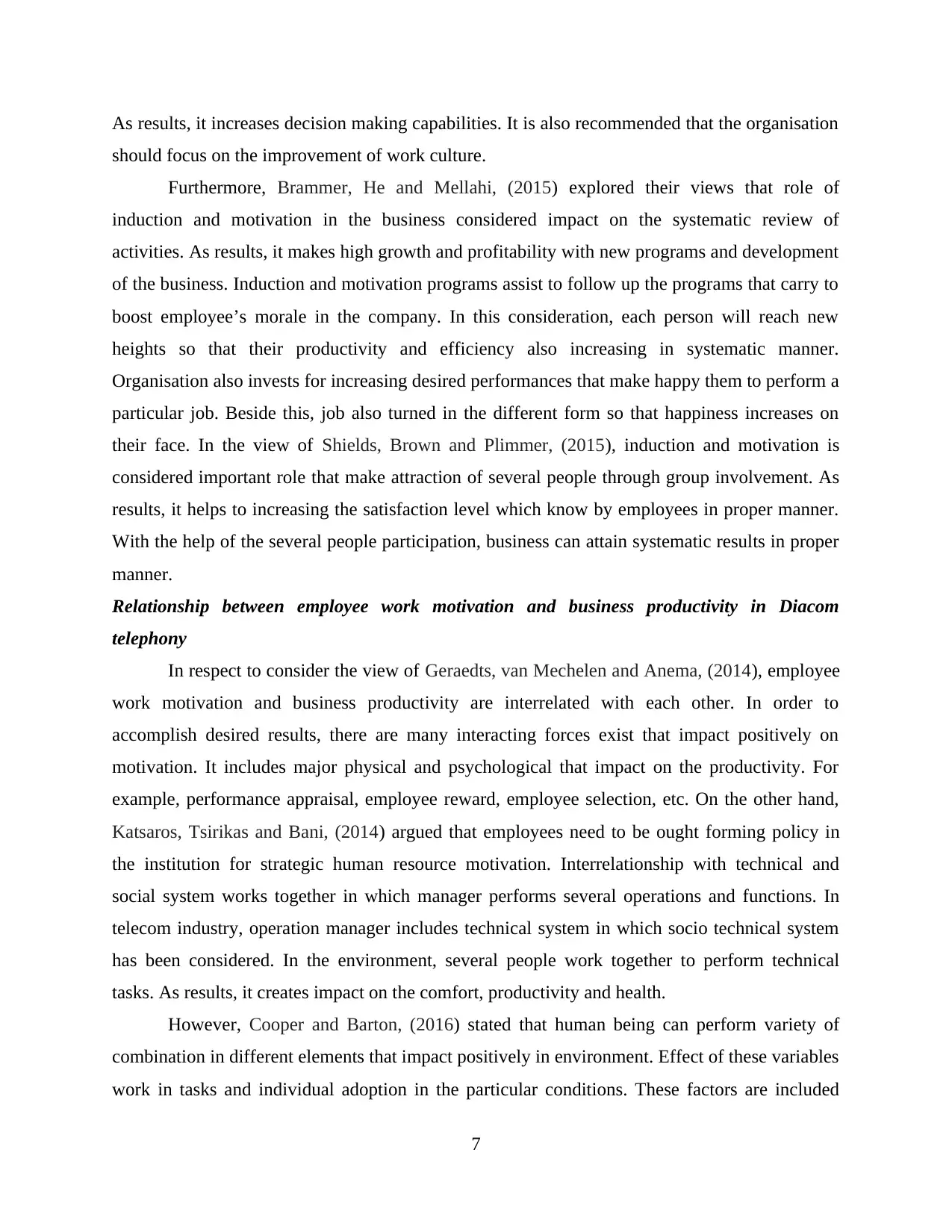
As results, it increases decision making capabilities. It is also recommended that the organisation
should focus on the improvement of work culture.
Furthermore, Brammer, He and Mellahi, (2015) explored their views that role of
induction and motivation in the business considered impact on the systematic review of
activities. As results, it makes high growth and profitability with new programs and development
of the business. Induction and motivation programs assist to follow up the programs that carry to
boost employee’s morale in the company. In this consideration, each person will reach new
heights so that their productivity and efficiency also increasing in systematic manner.
Organisation also invests for increasing desired performances that make happy them to perform a
particular job. Beside this, job also turned in the different form so that happiness increases on
their face. In the view of Shields, Brown and Plimmer, (2015), induction and motivation is
considered important role that make attraction of several people through group involvement. As
results, it helps to increasing the satisfaction level which know by employees in proper manner.
With the help of the several people participation, business can attain systematic results in proper
manner.
Relationship between employee work motivation and business productivity in Diacom
telephony
In respect to consider the view of Geraedts, van Mechelen and Anema, (2014), employee
work motivation and business productivity are interrelated with each other. In order to
accomplish desired results, there are many interacting forces exist that impact positively on
motivation. It includes major physical and psychological that impact on the productivity. For
example, performance appraisal, employee reward, employee selection, etc. On the other hand,
Katsaros, Tsirikas and Bani, (2014) argued that employees need to be ought forming policy in
the institution for strategic human resource motivation. Interrelationship with technical and
social system works together in which manager performs several operations and functions. In
telecom industry, operation manager includes technical system in which socio technical system
has been considered. In the environment, several people work together to perform technical
tasks. As results, it creates impact on the comfort, productivity and health.
However, Cooper and Barton, (2016) stated that human being can perform variety of
combination in different elements that impact positively in environment. Effect of these variables
work in tasks and individual adoption in the particular conditions. These factors are included
7
should focus on the improvement of work culture.
Furthermore, Brammer, He and Mellahi, (2015) explored their views that role of
induction and motivation in the business considered impact on the systematic review of
activities. As results, it makes high growth and profitability with new programs and development
of the business. Induction and motivation programs assist to follow up the programs that carry to
boost employee’s morale in the company. In this consideration, each person will reach new
heights so that their productivity and efficiency also increasing in systematic manner.
Organisation also invests for increasing desired performances that make happy them to perform a
particular job. Beside this, job also turned in the different form so that happiness increases on
their face. In the view of Shields, Brown and Plimmer, (2015), induction and motivation is
considered important role that make attraction of several people through group involvement. As
results, it helps to increasing the satisfaction level which know by employees in proper manner.
With the help of the several people participation, business can attain systematic results in proper
manner.
Relationship between employee work motivation and business productivity in Diacom
telephony
In respect to consider the view of Geraedts, van Mechelen and Anema, (2014), employee
work motivation and business productivity are interrelated with each other. In order to
accomplish desired results, there are many interacting forces exist that impact positively on
motivation. It includes major physical and psychological that impact on the productivity. For
example, performance appraisal, employee reward, employee selection, etc. On the other hand,
Katsaros, Tsirikas and Bani, (2014) argued that employees need to be ought forming policy in
the institution for strategic human resource motivation. Interrelationship with technical and
social system works together in which manager performs several operations and functions. In
telecom industry, operation manager includes technical system in which socio technical system
has been considered. In the environment, several people work together to perform technical
tasks. As results, it creates impact on the comfort, productivity and health.
However, Cooper and Barton, (2016) stated that human being can perform variety of
combination in different elements that impact positively in environment. Effect of these variables
work in tasks and individual adoption in the particular conditions. These factors are included
7
Paraphrase This Document
Need a fresh take? Get an instant paraphrase of this document with our AI Paraphraser
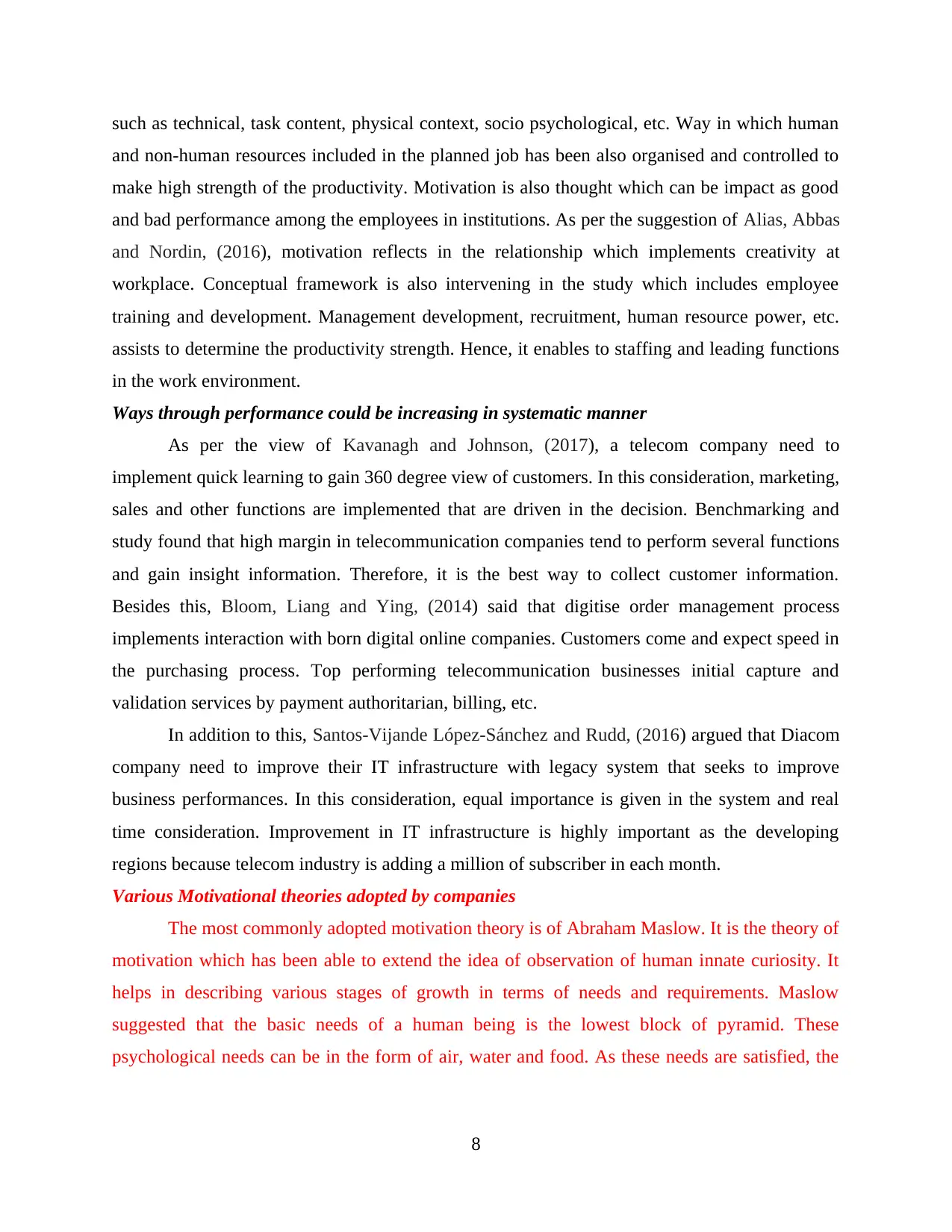
such as technical, task content, physical context, socio psychological, etc. Way in which human
and non-human resources included in the planned job has been also organised and controlled to
make high strength of the productivity. Motivation is also thought which can be impact as good
and bad performance among the employees in institutions. As per the suggestion of Alias, Abbas
and Nordin, (2016), motivation reflects in the relationship which implements creativity at
workplace. Conceptual framework is also intervening in the study which includes employee
training and development. Management development, recruitment, human resource power, etc.
assists to determine the productivity strength. Hence, it enables to staffing and leading functions
in the work environment.
Ways through performance could be increasing in systematic manner
As per the view of Kavanagh and Johnson, (2017), a telecom company need to
implement quick learning to gain 360 degree view of customers. In this consideration, marketing,
sales and other functions are implemented that are driven in the decision. Benchmarking and
study found that high margin in telecommunication companies tend to perform several functions
and gain insight information. Therefore, it is the best way to collect customer information.
Besides this, Bloom, Liang and Ying, (2014) said that digitise order management process
implements interaction with born digital online companies. Customers come and expect speed in
the purchasing process. Top performing telecommunication businesses initial capture and
validation services by payment authoritarian, billing, etc.
In addition to this, Santos-Vijande López-Sánchez and Rudd, (2016) argued that Diacom
company need to improve their IT infrastructure with legacy system that seeks to improve
business performances. In this consideration, equal importance is given in the system and real
time consideration. Improvement in IT infrastructure is highly important as the developing
regions because telecom industry is adding a million of subscriber in each month.
Various Motivational theories adopted by companies
The most commonly adopted motivation theory is of Abraham Maslow. It is the theory of
motivation which has been able to extend the idea of observation of human innate curiosity. It
helps in describing various stages of growth in terms of needs and requirements. Maslow
suggested that the basic needs of a human being is the lowest block of pyramid. These
psychological needs can be in the form of air, water and food. As these needs are satisfied, the
8
and non-human resources included in the planned job has been also organised and controlled to
make high strength of the productivity. Motivation is also thought which can be impact as good
and bad performance among the employees in institutions. As per the suggestion of Alias, Abbas
and Nordin, (2016), motivation reflects in the relationship which implements creativity at
workplace. Conceptual framework is also intervening in the study which includes employee
training and development. Management development, recruitment, human resource power, etc.
assists to determine the productivity strength. Hence, it enables to staffing and leading functions
in the work environment.
Ways through performance could be increasing in systematic manner
As per the view of Kavanagh and Johnson, (2017), a telecom company need to
implement quick learning to gain 360 degree view of customers. In this consideration, marketing,
sales and other functions are implemented that are driven in the decision. Benchmarking and
study found that high margin in telecommunication companies tend to perform several functions
and gain insight information. Therefore, it is the best way to collect customer information.
Besides this, Bloom, Liang and Ying, (2014) said that digitise order management process
implements interaction with born digital online companies. Customers come and expect speed in
the purchasing process. Top performing telecommunication businesses initial capture and
validation services by payment authoritarian, billing, etc.
In addition to this, Santos-Vijande López-Sánchez and Rudd, (2016) argued that Diacom
company need to improve their IT infrastructure with legacy system that seeks to improve
business performances. In this consideration, equal importance is given in the system and real
time consideration. Improvement in IT infrastructure is highly important as the developing
regions because telecom industry is adding a million of subscriber in each month.
Various Motivational theories adopted by companies
The most commonly adopted motivation theory is of Abraham Maslow. It is the theory of
motivation which has been able to extend the idea of observation of human innate curiosity. It
helps in describing various stages of growth in terms of needs and requirements. Maslow
suggested that the basic needs of a human being is the lowest block of pyramid. These
psychological needs can be in the form of air, water and food. As these needs are satisfied, the
8
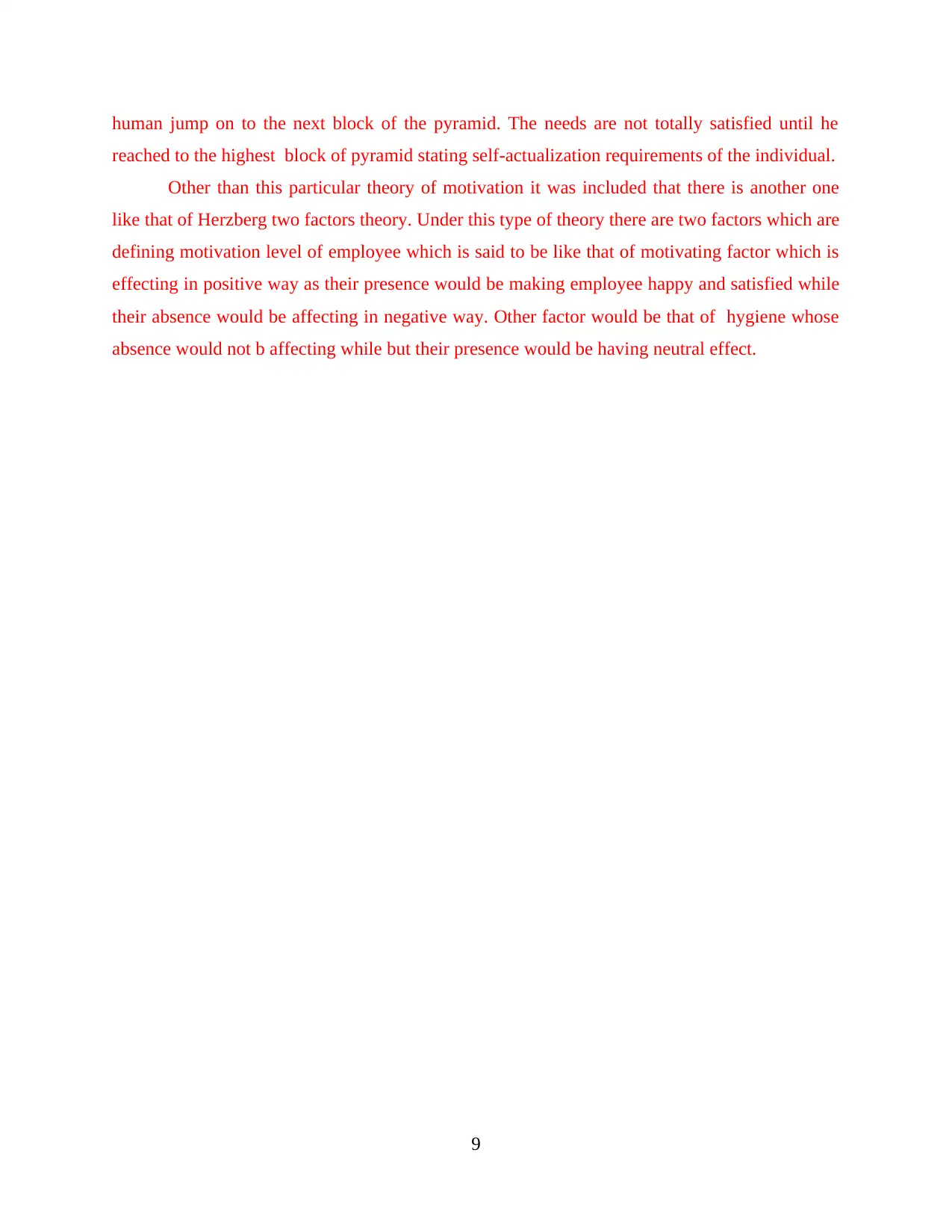
human jump on to the next block of the pyramid. The needs are not totally satisfied until he
reached to the highest block of pyramid stating self-actualization requirements of the individual.
Other than this particular theory of motivation it was included that there is another one
like that of Herzberg two factors theory. Under this type of theory there are two factors which are
defining motivation level of employee which is said to be like that of motivating factor which is
effecting in positive way as their presence would be making employee happy and satisfied while
their absence would be affecting in negative way. Other factor would be that of hygiene whose
absence would not b affecting while but their presence would be having neutral effect.
9
reached to the highest block of pyramid stating self-actualization requirements of the individual.
Other than this particular theory of motivation it was included that there is another one
like that of Herzberg two factors theory. Under this type of theory there are two factors which are
defining motivation level of employee which is said to be like that of motivating factor which is
effecting in positive way as their presence would be making employee happy and satisfied while
their absence would be affecting in negative way. Other factor would be that of hygiene whose
absence would not b affecting while but their presence would be having neutral effect.
9
⊘ This is a preview!⊘
Do you want full access?
Subscribe today to unlock all pages.

Trusted by 1+ million students worldwide
1 out of 31
Related Documents
Your All-in-One AI-Powered Toolkit for Academic Success.
+13062052269
info@desklib.com
Available 24*7 on WhatsApp / Email
![[object Object]](/_next/static/media/star-bottom.7253800d.svg)
Unlock your academic potential
Copyright © 2020–2025 A2Z Services. All Rights Reserved. Developed and managed by ZUCOL.




